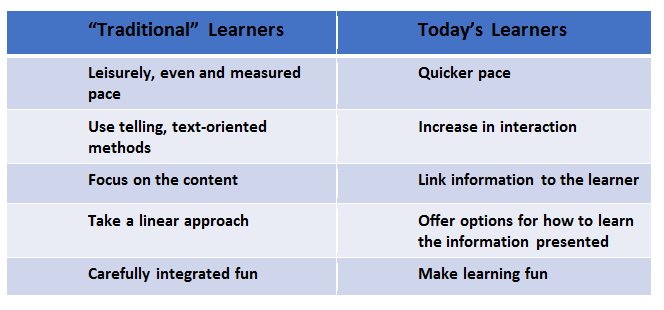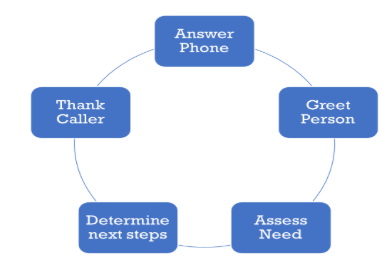Learning styles are defined as the way each person learns best. Just like we all have different personalities, we all have different learning styles as well. Sometimes we forget about that as teachers and trainers as our instinct is to teach people to do things the way we like to be taught. Probably not the best method! Today, our focus will be on defining potential learning styles and adapting our training to fit the needs of our students.
Learning Styles & Training Options
The three learning styles to think about as you put together or revamp your training are: Auditory, Visual, and Kinesthetic.
Auditory:
Focuses on individuals that learn best by hearing as it helps them internalize the concepts. These students learn best through listening to others speak. For this group, methods such as lectures and guest speakers or even group activities discussing topics would work best.
Visual:
Focuses on learning best when information is presented visually. For these students you want to focus on training via PowerPoint slides, using maps, or providing handouts.
Kinesthetic:
Focuses on training through action activities and putting them in the role. If being on the phone is part of their job, getting them on the phone with role play activities might work best.
The key to any great training program is diversifying your training to encompass all three learning styles. You must be flexible with your program and adapt based on the types of learners you have. Some students may not know how they learn best yet, and there are plenty of free learning assessments out there that I often use to get to know the student better to assist with training. If you are interested in some options, I’m happy to provide them to you if you reach out.
Learning in Today’s World
First and foremost, we all learn best when information we are absorbing has meaning to us. To start, think about how to create meaning for the student's role to gain buy-in to your training.
This is crucial no matter what learning style/s you may be working with. Students need to know the WHY behind everything as this generation wants to feel like the work they are doing has meaning. Once you have discussed their purpose and how their role is crucial for your department or organization, the training can begin.
The best way to train is always based on the individual/s and what you are training about. Multiple sensory methods should be created to make the learning experiences effective for all. If you have only 1 student to train, that makes things easier as you can stick with one method throughout. With 50 students that becomes much more difficult.
It’s crucial that your training program encompasses all learning styles and is flexible based on student needs. Plus, mixing up your training keeps them from falling asleep! This is especially imperative if you need a full day or even longer for training. Keep their attention by mixing it up while also reaching out to each learning style.
Training Considerations
Create your training around two questions:
- What do students need to understand?
- What do students need to be able to do?
To be effective, your first step must be to define learning outcomes, goals, and objectives for your training. Before you consider taking action and coming up with what your training looks like for each learning style, identify what students need to come out of training ready and able to do. As mentioned above, part of that is thinking about defining the “why” for students.
If you read my first blog on hiring and choosing the right students, you may recall the importance of setting the stage early, within the job description, by defining why this role will be important to the larger mission. If you need to, ask yourself why you hired the student in the first place and how they are going to benefit from the training. Doing so will give you an outline on where to start.
Execution of training will be crucial. Whatever you select as methods for each learning style, make them interactive. Attention spans are short! Use videos, collaborative activities, active discussions, and role play.
The common challenge to creating a great training program for each learning style is time. We don’t have enough, and we always need more. “I don’t have time to create this detailed of a training for my students”. My question back to that comment is always “can you afford to not spend the time on training effectively?” Without fully committing to a proper training, an already challenging task of managing students in a part-time role becomes much more challenging. This front-end work will pay off with better understanding and buy-in, and an increased student retention rate.
Traditional Workers vs. Today’s Learners
You may have noticed…today’s learners and workers do not learn the same as many traditionally have. Below, I focus on the differences in past vs present ways of learning along with aspects to consider for your training:

My challenge for you is to think about the characteristics of today’s learner and determine how you can touch on each of the 3 learning styles while tackling the above challenges.
Sample Methods
There are a couple sample methods I want to mention that our staff at the University of Iowa has found very effective:
Reflection 3-2-1
This method is simple and works well with students to help re-enforce key points from training. It’s also a good way to check their knowledge and see if you need to revamp your training or focus more on certain topics or learning styles for the next round. Thinking about this writing as an example, here is a possible 3-2-1:
List three things you can do to engage your students in training, considering different strategies for each learning style.
What are two things you learned from reading this article?
What is one thing you can do to improve your training to help students of all learning styles succeed?
Connecting Learning—Mind Map Exercise
As an example, if you are training students on interacting with customers/patients/clients on the phone, the map below shows what a typical structure might look like.
For visual learners, this map may be very helpful in providing them an idea of the structure of each call. For our auditory learners, you can discuss each part and what it might be like. Finally, for kinesthetic learners you can act out potential phone call situations via role play.

These are just two of the many examples of potential training methods that can be used to hit all learning styles.
Final Thoughts
Have you ever taught or trained a student and realized they just are not understanding what you’re trying to get them to learn? It’s so easy why can’t they get it?!! More times than not, it’s because they don’t learn the same way that you do.
We are all different, and that goes for the way we learn as well. To maximize performance of your students in any setting, be cognizant of different learning styles and reflect on your methods and ask yourself if you are putting your students in the best position to succeed. Best of luck with your students!
Don't miss Josh Frahm's November Blog: Engaging Generation Z